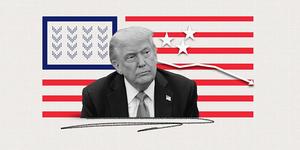WASHINGTON, D.C. — Republicans’ and Democrats’ evaluations of both the Supreme Court and Congress have never diverged more than in Gallup’s latest update.
Seventy-five percent of Republicans versus 11% of Democrats approve of the job the Supreme Court is doing, according to a July 7-21 poll. This 64-percentage-point party gap exceeds the prior high of 61 points, recorded after the high court overturned Roe v. Wade in its 2022 Dobbs ruling.
At the same time, 55 points separate Republicans’ (61%) and Democrats’ (6%) approval of Congress. That ties with another 55-point party gap from March as the largest in Gallup’s trend dating back to 1974.
These record-high party gaps in the ratings of the federal legislative and judicial institutions are consistent with increasingly politically polarized opinions of U.S. presidents. The presidential party gap has averaged about 80 points since 2017 for both Donald Trump and Joe Biden, 10 points higher than for any prior president.
Half of the 10 largest partisan gaps in Supreme Court approval have come after the Dobbs decision, handed down by a solid 6-3 conservative majority on the court. During this time, the court has earned high marks from Republicans and very low marks from Democrats.
Many of the earlier politically polarized evaluations came when a more ideologically split Supreme Court issued rulings that pleased liberals and angered conservatives, resulting in much higher ratings from Democrats than Republicans. These include the 2015 Obergefell decision that legalized same-sex marriage and the 2012 and 2015 decisions that upheld key provisions of the Affordable Care Act. These ratings occurred during Barack Obama’s presidency, which may have also influenced Democrats to be more satisfied than Republicans with the court.
The most polarized evaluations of Congress have primarily come in the early stages of the Trump and Biden administrations, when they worked with a Congress controlled by their own party to enact the most significant parts of their policy agendas. Just before the latest poll’s interviewing began, congressional Republicans passed the One Big Beautiful Bill Act that reduced federal taxes, expanded funding for border security and deportation efforts, and cut federal funding for Medicaid.
Supreme Court Approval Below 40% for First Time
The 11% Democratic approval rating of the Supreme Court is the lowest Gallup has measured for any party group in the court’s trend. Combined with a record-low 34% rating among political independents, the court’s overall approval rating is below 40% for the first time. The current 39% rating is, however, not meaningfully different from several 40% measures between 2021 and 2023, given Republicans’ current high ratings of the court.
When Gallup first measured Supreme Court job approval in the early 2000s, ratings were typically near 60%.
The court’s approval has been consistently below 50% since 2021, while the court has had a 6-3 conservative majority.
Over the course of Gallup’s trend, Supreme Court job approval has typically been higher among supporters of the president’s party, including among Republicans from 2001 to 2008, Democrats from 2009 to 2016, and Republicans from 2017 to 2020.
In the first year of Biden’s presidency, party gaps were muted, when the Democratic president was in office along with a conservative court. Once the court handed down the Dobbs decision in 2022, Republicans’ approval of the court surged, while Democrats’ plummeted. Significant party gaps have persisted since then, largely because of continued low ratings from Democrats.
Republicans’ 75% approval rating of the court ranks among the highest in the trend, slightly below the all-time high of 80% measured in January 2001. This reading came shortly after the court’s decision in the 2000 presidential election dispute resulted in Republican George W. Bush winning the state of Florida’s electoral votes and the presidency.
Democrats’ and independents’ prior low evaluations of the Supreme Court came in the first and second polls, respectively, conducted after the Dobbs decision.
Republican Approval of Congress Near 20-Year High; Democratic Approval Near Low
Overall, congressional job approval currently sits at 26%, slightly down from the four-year high of 31% observed in March. Congressional approval has been higher this year than in the months leading up to Trump and the Republicans coming into power.
Gallup observed a similar spike in approval during the early part (February through September 2021) of the Biden administration and Democratic-led Congress. By October 2021, congressional approval fell to the low 20s and ranged from 12% to 23% until February 2025, when it rebounded to 29%.
Republicans’ current 61% approval of Congress essentially ties their 63% from March as the highest in two decades. During Trump’s first term, Republican approval only reached as high as 50% when the party held majorities in Congress from 2017 to 2018. The all-time high for congressional job approval among Republicans was 89% in October 2001, following 9/11, when the country rallied around President George W. Bush and other government leaders and institutions.
Meanwhile, congressional approval today is just 6% among Democrats, one of the lowest ratings recorded for this group, along with 4% in June 2025, 5% in October 2013 and February 2025, and 6% in March 2018. The October 2013 and March 2018 lows occurred after federal government shutdowns.
For Democrats and Republicans, 2025 looks like a reversal of 2021 congressional job approval. In February 2021, Republican approval of Congress was 8%, while Democrats’ rating of 61% represented their highest approval since April 2009.
Independents’ approval of Congress has held at a low level in recent months and is currently at 19%. It has generally been lower this year under Republican control, ranging between 17% and 26%, than it was in 2021 under Democratic control, when it ranged from 25% to 35%. The all-time low for independents’ approval of Congress was 7% in December 2011, when control of Congress was split.
Generally, partisans’ approval of Congress tends to flip based on which party has control — and when there is divided control, approval is depressed among supporters of both parties. For example, between January 2023 and December 2024, when Republicans had a majority in the House and Democrats had more Senate seats, an average of 12% of Republicans, 18% of independents and 20% of Democrats approved of Congress.
Bottom Line
Americans’ assessments of the job the Supreme Court and Congress are doing have never been more divergent by party than they are now. These record-high partisan gaps have come amid a highly polarized U.S. political and media climate, which often leads to greater scrutiny of the actions of political actors and government institutions. This is especially the case when government institutions’ composition, actions or decisions suggest a clear partisan leaning. Such situations lead to one party’s supporters hailing the institution’s work while the other has overwhelmingly negative views.
Stay up to date with the latest insights by following @Gallup on X and on Instagram.
Learn more about how the Gallup Poll Social Series works. View complete question responses and trends (PDF download).




